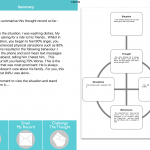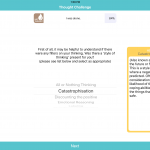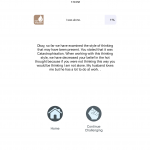Pocket CBT seeks to make a Cognitive Behavioral Therapy (CBT) tool available in a convenient iPhone app. The app helps individuals identify their thoughts, physiological sensations, emotional state, and behaviors in a particular event. It further allows individuals to label dysfunctional thoughts, or styles of thoughts, and overcome those dysfunctional thoughts with alternative and adaptive thoughts and behaviors.
Version: 1.3.6 (IOS)
Compatibility: Available on all iOS devices
Price: $4.99
Target Audience: Practitioners using Cognitive Behavioral Therapy.
Bottom Line: Pocket CBT provides a useful tool for practitioners, utilizing Cognitive Behavioral Therapy as their mode of intervention.
Not a valid Json Element
Likes |
Dislikes |
|
|
Features and Options:
Cognitive Behavioral Therapy proposes that individuals experience improved emotional states and behaviors when they have the capacity to label dysfunctional thinking and evaluate their thoughts in a realistic way. (Beck, 2011). A practitioner administering CBT helps clients “identify, evaluate, and respond to their dysfunctional thoughts and beliefs (Beck, 2011, 10).” Pocket CBT can be utilized to teach individuals to identify dysfunctional cognitions and behaviors as well as incorporate learned skills to address problematic thoughts and behaviors.
Pocket CBT has two main steps. In step one, the user creates a thought record, breaking the problem down into physiological sensations, emotions, thoughts, and behaviors associated with a given situation. In step two, the user challenges that thought by: 1) finding their thinking style, 2) de-centering (removing it), 3) challenging the thought, and 4) reflecting.
Thought Records
The user’s home screen keeps record of all of the user’s past thought records. When starting a new thought record, the user is prompted to describe the situation. Next, the user is asked to label the most upsetting thought, what that thought meant to them, and rate how intensely they believed this thought was true. Then, the user is asked to identify and rate the strongest physiological sensations and emotions associated with the thought. Finally, the user identifies how they reacted in response to their thoughts and emotions and how that behavior made them feel.
After every component is complete, the user is provided with a one paragraph summary of the thought record and a diagram, which includes the situation, thoughts, physiological sensations, emotions, and behaviors. The diagram is based on Padesky’s Cross-Sectional Formulation and can be shared with a practitioner via email.
Challenging the Thought
If the user chooses to challenge the thought in step two, he or she is reminded of the most upsetting thought (“hot thought”) in the thought record and the intensity of the thought. Next, the user is asked to choose the style of thinking that was present in the situation. The app provides a definition for each style of thought.
Next, the user is prompted to describe the effects of the style of thought on the event and how the event might have been different if this style was not utilized. The user can chose to challenge their thought again, selecting another relevant style of thought. The user’s thought challenges are stored in their home screen but are not sharable via email.
Practice Implications:
“Homework is an in integral, not an optional part of cognitive behavioral therapy (Beck, 2011, 294).” “Homework, properly assigned and completed, speeds progress and allows patients to practice the techniques of therapy which they will need when therapy is over (Beck, 2011, 315).” Pocket CBT could be an appropriate assignment for many clients. A practitioner could use pocket CBT to educate clients on the principles of CBT or could use a shared thought record diagram to administer CBT. Pocket CBT may also serve as a tool that clients use after therapy concludes as they seek to maintain their CBT skills.
Privacy Policy Disclaimer: Unable to locate information on privacy policy.
Device used for this review: IPad
Works Cited:
Beck, J. S. (2011). Cognitive Behavioral Therapy. New York: The Guilford Press.






